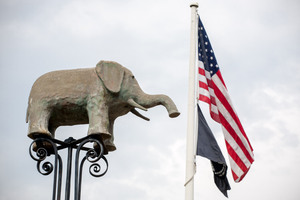
Emily Hoffert and Janice Wylie were in their early twenties and had just begun working in New York City when they were killed by an intruder in their Upper East Side apartment in August 1963. Both girls had been stabbed, and Wylie sexually assaulted. Hoffert and Wylie were members of a new generation of “career girls,” young white working women in New York, and their case captured public attention partly because of a preexisting moral anxiety—was it safe for young women to live and work in the city on their own, or was this a case of liberation gone too far?
When New York police arrested George Whitmore, a black teenager who confessed to the murders, many people felt that their assumptions about “career girls”—that seeking a career was reckless, that the city was no place for a young woman, that living in New York would expose innocent white girls to a seedy non-white urban underbelly—had been confirmed.
For people skeptical about the burgeoning movement for women’s independence in financial matters, housing, and employment, the murders of Hoffert and Wylie represented a worst-case scenario. The women were unmarried, working their way up the career ladder, living away from their families, and subject to all manner of urban dangers. Both were college graduates with “respectable” white-collar jobs—Wylie was at Newsweek and Hoffert was about to start a job as a teacher, positions that indicated the girls’ good social standing. And yet they were brought low by their own ambitions, and by exposure to what white America thought of as unsavory elements.
Unlike poor, often non-white women who had been working outside the home for decades, Hoffert and Wylie and other women deemed “career girls” were from well-to-do families and were choosing to leave home for the glitz and glamor of New York. In many cases, career girls were looking for work between college and marriage—a foray into socially acceptable independence that would, in theory, then come to an end. The New York Times reported that the girls were daughters of professionals (Hoffert’s father was a surgeon and Wylie’s a writer); in other words, they weren’t forced into employment by bad economic circumstances. Instead, it seemed, they were victims of independence.
In the wake of the murders, the parents of other "career girls" took measures to curtail their own daughters' independence. In a piece for the Times after the murders, Gay Talese quoted “a father” from New Rochelle, New York, who had decided not to let his 22-year-old daughter move to the city. “‘Yeah, you’ll get an apartment—over my dead body,’” the man told Talese, echoing the worried sentiments of other parents rethinking the idea of allowing their daughters out of their sight.

The idea that keeping young white women close to home would somehow save them from harm was reproduced on a larger scale in the aftermath of the murders. In her article “The Career Girls Murders: Gender, Race and Crime in 1960s New York” in the journal Women’s Studies Quarterly, Marilynn C. Johnson writes that the Wylie-Hoffert case ultimately served to limit the freedoms of young women and the black suspects that were so often accused in crimes against them. “For young women, the discourse of crime prevention sent an unmistakably repressive message: secure your home, limit your mobility, and seek out male protectors—or better yet, avoid the urban career world altogether,” she writes. In crime studies of this period, Johnson notes, societal consensus dictated that women were largely responsible for their own fate at the hands of men—no matter the circumstance—and career girls’ newfound urban independence could come at a cost.
The new freedom Johnson discussed was thoroughly interrogated by the media and other public figures, including Janice Wylie’s father Max. In 1964, Max Wylie, a novelist, published Career Girl, Watch Your Step!, a book filled with instructions and advice for, presumably, girls like his daughter who were making their way in the big city without the protection of men. In the aftermath of the murders, the Times kept a close eye on the case and its effects on Wylie and Hoffert’s neighbors. Some “1,000” tips were called into the police, but no arrests were made for months, further stoking fears that the killer was still at large. The NYPD also released a pamphlet on self-defense and safety for young women called “A Message to Women,” and set up extra phone hotlines for women to report threats and sexual assaults.
This increased interest in women’s safety helped to highlight the everyday aggression that women faced in the city, but the effort had a few blind spots. It put the onus of prevention on the women themselves, instead of on men or law enforcement. And campaigns to end the violence and harassment of women were largely limited to those young white women whose circumstances were similar to Hoffert and Wylie’s. In contrast to the career girls murders, New York media didn’t pay the same level of attention to violent crimes against poor women of color.
This was especially evident when comparing the coverage of Hoffert and Wylie with the two other crimes that Whitmore confessed to: the attempted rape of Elba Borrero and the murder of Minnie Edmonds, both women of color from Brooklyn. When the New Yorker reported on the ongoing case in 1969, the distinction between the career girls and Borrero and Edmonds was made very clear: “This killing was also a brutal one,” the article stated of Edmonds’ death, “but the social position of the victim (Mrs. Edmonds was a Negro dayworker) and the site of the crime (Brownsville, a dismal slum) insured that it would receive very little public attention.” In contrast, newspapers fixated on career girls for years, focusing on violent crimes against young white women in classy neighborhoods as crime rates rose in New York. This approach, says Johnson, further fanned the flames of racial tension in the city, as many white conservatives conflated a rise in crime with a rise in crimes perpetrated by people of color against white people and called for harsher punishments as a result.

As it turned out, Whitmore wasn’t the killer. He eventually recanted his confession, and the case became an important part of legal history when detectives’ unjustified arrest and coercion was used as an example in the Supreme Court case that led to mandated Miranda warnings. Police detectives ignored the holes in Whitmore’s story, including his whereabouts on the day of the murders and his knowledge of the attack. Despite the issues surrounding the investigation, Whitmore spent months in prison for the crimes until another man, Richard Robles, confessed in 1965, telling police that he killed the women during a robbery gone wrong. Robles was ultimately convicted, but not before Whitmore had served time for a crime he didn’t commit.
As Hoffert and Wylie’s deaths have come to represent a cultural flashpoint for the treatment of working women by media and law enforcement, the investigation of George Whitmore has also served as a cautionary tale for what can happen to disadvantaged suspects caught in the eye of the storm. For Whitmore, a teenager with reported intellectual disabilities, being a suspect led to forced confessions and jail time, even after Robles came forward. Even as Whitmore’s story contributed to the Miranda rights law, the officers who beat, coerced, and withheld evidence from him were not convicted of any wrongdoing. Further, the late 1960s brought Richard Nixon’s harsh law-and-order approach to policing, which disproportionately affected poor people of color when it came to conviction and incarceration.
Hoffert and Wylie came to represent the dangers that women could face if they tried to have careers in the big, bad city—the combination of danger and glamor was irresistible for the media, particularly given the girls’ class positions and the gruesome nature of their deaths. In Talese’s article on August 31, an astute New Yorker told him that the attention paid to the crimes was purely a result of the victims’ social status and the pedigree of the neighborhood: “Look, we’re all horrified, but these things happen. If they happened in Brooklyn or Harlem—where they happen every day—we wouldn’t hear a thing about it. So it happened in a ‘good’ neighborhood. Well, I’m sorry, but believe me, in a few days in New York it’ll only be the poor girls’ parents and friends who will care.”
The woman’s matter-of-fact approach to the story speaks to the realities of crime for so many people, but she was wrong about the career girls’ legacy—more than 50 years on, they haven’t been forgotten.



























































